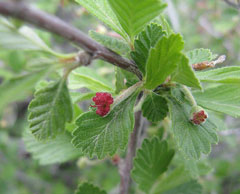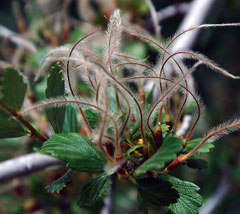 |
|
|
 |
| http://commons.wikimedia.org/wiki/User:Maylett |
Translate this page:
Summary
Main Bloom Time: Early summer, Early spring, Late summer, Late spring, Mid summer, Mid spring. Form: Oval, Upright or erect.
Physical Characteristics

 Cercocarpus montanus is an evergreen Shrub growing to 4 m (13ft 1in) at a medium rate.
Cercocarpus montanus is an evergreen Shrub growing to 4 m (13ft 1in) at a medium rate.
See above for USDA hardiness. It is hardy to UK zone 5. It is in leaf all year, in flower from May to June. The species is hermaphrodite (has both male and female organs) and is pollinated by Insects.
It can fix Nitrogen.
Suitable for: light (sandy), medium (loamy) and heavy (clay) soils and prefers well-drained soil. Suitable pH: mildly acid, neutral and basic (mildly alkaline) soils. It cannot grow in the shade. It prefers dry or moist soil and can tolerate drought. The plant can tolerate maritime exposure.
UK Hardiness Map
US Hardiness Map
Synonyms
Plant Habitats
Woodland Garden Sunny Edge; Hedge;
Edible Uses
References More on Edible Uses
Medicinal Uses
Plants For A Future can not take any responsibility for any adverse effects from the use of plants. Always seek advice from a professional before using a plant medicinally.
Laxative Stomachic Tonic
An infusion of the leaves has been used as a general strengthened to the system[257]. The roots and the bark have been used in the treatment of stomach complaints[257]. A cold infusion of the plant or leaves has been used as a laxative[257].
References More on Medicinal Uses
The Bookshop: Edible Plant Books
Our Latest books on Perennial Plants For Food Forests and Permaculture Gardens in paperback or digital formats.

Edible Tropical Plants
Food Forest Plants for Hotter Conditions: 250+ Plants For Tropical Food Forests & Permaculture Gardens.
More

Edible Temperate Plants
Plants for Your Food Forest: 500 Plants for Temperate Food Forests & Permaculture Gardens.
More

More Books
PFAF have eight books available in paperback and digital formats. Browse the shop for more information.
Shop Now
Other Uses
Broom Dye Fuel Hedge Hedge Wood
Bunches of the tied stems have been used as rough brooms[257]. A red to brown dye can be obtained from the root bark[257]. The bark is often mixed with alder and wild plum root barks when making the dye[257]. Tolerant of maritime exposure and amenable to training, this species can be grown as a hedge in seaside gardens[K]. The wood is heavy, hard and brittle[82]. It makes a valuable fuel and is occasionally used in the manufacture of small articles for domestic and industrial use[82].
Special Uses
Food Forest Hedge Hedge Nitrogen Fixer
References More on Other Uses
Cultivation details
Landscape Uses:Erosion control, Hedge, Screen. Requires a perfectly drained soil in a sunny position[200]. Tolerant of salt spray[200]. Succeeds in a hot dry position. This species has many sub-species. Whilst some forms are hardy to about -17°c when in a suitable soil and position, other forms are frost tender. The hardiest forms, succeeding in zone 5, are C. montanus argenteus (Rydb.)F.L.Matinn and C. montanus glaber (S.Wats.)F.L.Martin. Less hardy are C. montanus paucidentatus (S.Wats.)F.L.Martin which succeeds in zone 7, C. montanus blanchae (C.Schneid.)F.L.Martin and C. montanus minutiflorus (Abrams.)F.L.Martin are hardy in zone 8 whilst C. montanus traskiae (Eastw.)F.L.Martin. is the least hardy, to zone 9[200]. Some members of this genus have a symbiotic relationship with certain soil micro-organisms, these form nodules on the roots of the plants and fix atmospheric nitrogen. Some of this nitrogen is utilized by the growing plant but some can also be used by other plants growing nearby[200, 212]. Special Features:North American native, Inconspicuous flowers or blooms. The plant is heat tolerant in zones 9 through 6. (Plant Hardiness Zones show how well plants withstand cold winter temperatures.
Plant Heat Zones show when plants would start suffering from the heat.
The Plant Heat Zone map is based on the number of "heat days" experienced in a given area where the temperature climbs to over 86 degrees F (30°C).
At this temperature, many plants begin to suffer physiological damage. Heat Zones range from 1 (no heat days) to 12 (210 or more heat days).
For example Heat Zone. 11-1 indicates that the plant is heat tolerant in zones 11 through 1.) For polyculture design as well as the above-ground architecture (form - tree, shrub etc. and size shown above) information on the habit and root pattern is also useful and given here if available. The plant growth habit is multistemmed with multiple stems from the crown [1-2].
References Carbon Farming Information and Carbon Sequestration Information
Temperature Converter
Type a value in the Celsius field to convert the value to Fahrenheit:
Fahrenheit:
The PFAF Bookshop
Plants For A Future have a number of books available in paperback and digital form. Book titles include Edible Plants, Edible Perennials, Edible Trees,Edible Shrubs, Woodland Gardening, and Temperate Food Forest Plants. Our new book is Food Forest Plants For Hotter Conditions (Tropical and Sub-Tropical).
Shop Now
Plant Propagation
Seed - sow autumn or late winter in a cold frame. Seed of the more tender forms is best sown in the late winter whilst hardier forms are best sown in the autumn. When they are large enough to handle, prick the seedlings out into individual pots and grow them on in a cold frame for at least their first winter. Plant them out into their permanent positions in late spring or early summer, after the last expected frosts. Cuttings of half-ripe wood, July/August in a frame.
Other Names
If available other names are mentioned here
Native Range
NORTHERN AMERICA: United States, Nebraska (west), Oklahoma, South Dakota (southwest), Colorado, Wyoming, New Mexico, Texas, Utah,
Weed Potential
Right plant wrong place. We are currently updating this section.
Please note that a plant may be invasive in one area but may not in your area so it's worth checking.
Conservation Status
IUCN Red List of Threatened Plants Status :

Growth: S = slow M = medium F = fast. Soil: L = light (sandy) M = medium H = heavy (clay). pH: A = acid N = neutral B = basic (alkaline). Shade: F = full shade S = semi-shade N = no shade. Moisture: D = dry M = Moist We = wet Wa = water.
Now available:
Food Forest Plants for Mediterranean Conditions
350+ Perennial Plants For Mediterranean and Drier Food Forests and Permaculture Gardens.
[Paperback and eBook]
This is the third in Plants For A Future's series of plant guides for food forests tailored to
specific climate zones. Following volumes on temperate and tropical ecosystems, this book focuses
on species suited to Mediterranean conditions—regions with hot, dry summers and cool, wet winters,
often facing the added challenge of climate change.
Read More
Expert comment
Author
Raf.
Botanical References
Links / References
For a list of references used on this page please go here
Readers comment
| Add a comment |
|
If you have important information about this plant that may help other users please add a comment or link below. Only comments or links that are felt to be directly relevant to a plant will be included. If you think a comment/link or information contained on this page is inaccurate or misleading we would welcome your feedback at [email protected]. If you have questions about a plant please use the Forum on this website as we do not have the resources to answer questions ourselves.
* Please note: the comments by website users are not necessarily those held by PFAF and may give misleading or inaccurate information.
To leave a comment please Register or login here All comments need to be approved so will not appear immediately.
|
Subject : Cercocarpus montanus
|
|
|
|